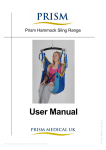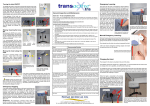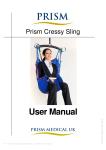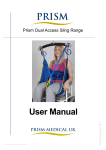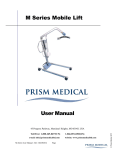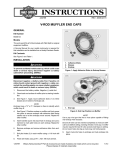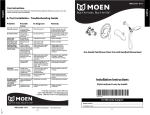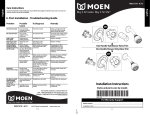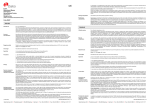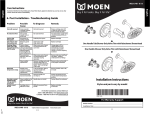Download Universal User Guide - Oct 2010 - BR
Transcript
Prism Universal Sling Range PL1 - Prism Universal User Guide - Doc 001 - Rev 10/2010 © Prism Medical UK 2010 User Manual Prism Universal Sling Application The Universal sling is designed for ease of fitting and general purpose transfer. It can be used to transfer from the seated to recumbent position or from recumbent to seated. The person must be assessed by a competent person who must be fully trained in the suitability, application and fitting of the sling. Carers should always be trained in the use of hoists and slings. Sling Inspection All Prism slings are manufactured to meet and exceed the requirements of BS EN 10535:2006. Slings should be inspected prior to use and after washing. Damaged or badly worn slings should be discarded.. The label on the sling contains vital information to identify the sling - if any part of the label becomes illegible, then it must be removed from service and replaced. The sling should be visually inspected with regard to the following items:• Any signs of damage (i.e. Cuts, frays, tears, burns) to the sling straps. • Any signs of stitching becoming undone on any part of the sling. • Any signs of the fabric being stretched, tearing or undue wear. • Any signs of discolouring or bleaching on the material. • Is the sling complete? i.e. All straps present, stiffeners in place - where applicable, etc. • Label clearly legible. Compatibility The issue of sling compatibility with various manufacturers’ hoists has been a concern for specifiers for a number of years, an issue that is compounded by the increased number of companies supplying hoists and slings. Some hoist/sling manufacturers will state that only slings manufactured by them can be used on their hoists and vice versa. This is their policy only and is NOT a legal requirement. A risk assessment must still be completed even if the same manufacturer of hoist and sling are to be used, and the specifier simply has to state that the carry bar is of a similar design and that the sling manufacturer has authorised its use on it. A comprehensive list is available separately and your local agent will be able to provide assistance with compatibility issues. The maximum load for the sling is clearly marked on the label of the sling. The maximum load will also be displayed on the hoist and any detachable elements of the hoisting system. DO NOT exceed the maximum load stated on any of the equipment. PL1 - Prism Universal User Guide - Doc 001 - Rev 10/2010 © Prism Medical UK 2010 Maximum Load (Safe Working Load - S.W.L) Sling Dimensions A D E B A B C D E Child 610 770 390 380 610 Junior 750 940 490 450 750 Small 825 1050 560 490 850 Medium 990 1215 660 555 1025 Large 1070 1350 710 640 1120 X Large 1150 1440 740 700 1200 All dimensions have a tolerance of +/- 20mm PL1 - Prism Universal User Guide - Doc 001 - Rev 10/2010 © Prism Medical UK 2010 C Hoisting from a chair Note: The person to be transferred shall be referred to as “the person”. 1 2 Introduce the sling by sliding it down between the chair backrest and the person’s back until the top of the commode aperture reaches the base of the spine. If the sling can not be introduced from behind, apply the sling in a position level with the person. Leave the sling half way down the persons back (at this stage don’t bring the sling to shoulder level). Bring the leg sections along-side the person’s thighs and pull lightly to ensure that they are of equal length. Using good manual handling techniques, block the persons leg to stop them from moving forward whilst the sling is being pulled into position. Raise the persons leg and feed the leg sections under the person’s thighs. Ensure the sling is not twisted or creased underneath the thighs. Important - At the base of the leg section strap there is a loop. Bring the straps together by passing one strap through the loop. Now raise the top of the sling level with the person’s shoulders. The fitting of the sling is now complete The six straps should now be attached to the carry bar hooks. Raise the carry bar just enough to tension the straps and ensure that they are still securely attached. The person can now be lifted as required. To remove the sling, carry out the fitting procedure in reverse. Important - always peel the sling away from the person to avoid skin friction and movement. HOW TO FIT FROM SEATING POSITION PL1 - Prism Universal User Guide - Doc 001 - Rev 10/2010 © Prism Medical UK 2010 4 3 Hoisting from a lying position Using good manual handling techniques roll the person towards you so that they are positioned onto their side. To introduce the sling, roll half of the sling up underneath itself so that when the person is rolled onto their opposite side, the sling can be unrolled until it is flat. Use the centre markers to ensure the base of the back section is in line with the base of the person’s spine. Ensure that handle loops are to the outside. 3 2 Pass the leg section under and up in-between the thighs. Ensure that as much of the leg section as possible is pulled under the leg and that all creases are eliminated to achieve maximum comfort. Important - At the base of the leg section strap there is a loop. Bring the straps together by passing one strap through the loop. The fitting of the sling is now complete. Hoisting from the floor Before commencing procedure, introduce The six straps should now be attached to a pillow to protect the person’s head from the carry bar hooks. Raise the carry bar the hoist. Follow the procedures 1-2 as above. just enough to tension the straps and Before undertaking stage 3, when using a ensure that they are still securely mobile hoist, introduce the hoist by attached . coming in from behind the head of the person where possible. Important - ensure The person can now be lifted as required. brakes are on. Procedure 3 can now begin. To remove the sling, carry out the fitting procedure in reverse. Important - always peel the sling away from the person to avoid skin friction and movement. PL1 - Prism Universal User Guide - Doc 001 - Rev 10/2010 © Prism Medical UK 2010 1 Prism Universal Sling - Material Variants / Uses Poly - The sling is made from a close knit polyester material and has nylon ripstop material to the outer side of the leg sections to aid the fitting of the sling. This is a general purpose sling and can be used for sitting and recumbent transfers between chairs, beds, floor, baths, changing beds, W.C’s etc. Slipfit - The sling is made from a nylon ripstop (parachute style) material and has been designed to be easily fitted and removed. It is especially suited to situations where the client has limited ability to be moved to aid fitting the sling i.e. tight fitting chairs. This is a general purpose sling that can be used as the Poly, but cannot be used in a bath as it will retain water around the client when being hoisted. Spacer - The sling is made from knitted polyester “spacer” fabric that is manufactured with an ‘air gap’ internally. The material stretches slightly in all directions and moulds perfectly to the shape of the person being hoisted. This is a general purpose sling that can be used as the Poly, but has the added benefit of being suitable to be left in position if required (subject to risk assessment and monitoring of pressure risks). Mesh - The sling is made from a polyester net material and has a non-absorbent foam in the leg sections. The inner surface of the leg sections has a close knit polyester covering for patient comfort. This sling is designed specifically for bathing and can be left in place whilst the person is being bathed / showered. CE Marking - Declaration of Conformity Registered Manufacturer No: CA003907 Prism UK Medical hereby declares that the Prism sling range meets the provisions of the European Union Council Directive 2007 / 47 / EEC concerning medical devices and are classified as Class 1 devices in accordance with that Directive. Universal Sling We hereby certify that the products listed above are manufactured, labelled and packaged in accordance with the provisions of Directive 2007 / 47 / EEC and conform in all aspects to the specification(s) relevant to them at the time of despatch and are CE marked in accordance with Directive 2007 / 47 / EEC . ……………………………. Signed : For Prism Medical UK PL1 - Prism Universal User Guide - Doc 001 - Rev 10/2010 © Prism Medical UK 2010 Serial Number …………………………………………. SLING CARE: LAUNDERING GENERAL. Sensitive laundering of lifting slings will extend the service life of the product. Conversely, improper laundering will reduce the service life and possibly affect the strength and integrity of the sling. To be avoided: use of bleach at washing, particularly hypochlorite [may cause structural damage] • overheating the sling [temperatures in excess of 100º may cause extreme shrinkage and structural damage] • Use of biological detergents is not recommended: though this type of detergent has no detrimental effect on the sling, the user’s skin may be sensitive to any residue. The use of fabric conditioners is not recommended. Any hook & loop fastenings should be closed prior to laundering to avoid the ‘hook’ side damaging the sling or other items laundered with it. GENERAL SOILING. The sling should be laundered with soap or detergent at 50°C on a standard domestic cycle. DISINFECTION. The sling should be laundered to ensure a ‘period at temperature’ of: • 10 minutes at 65ºC • 3 minutes at 72ºC Following NHS guidelines, extra time should be added to ensure thorough mixing of hot water through the wash load. It may be that available equipment does not allow the required level of temperature control. The sling may be washed on a 90ºC wash cycle, though it is likely that some moderate shrinkage and/or colour bleed will occur. DRYING. Do not allow the sling to overheat. The sling should last in excess of 5 years if the above guidelines are adhered to. All Prism slings have a manufacturers guarantee of 12 months. PL1 - Prism Universal User Guide - Doc 001 - Rev 10/2010 © Prism Medical UK 2010 Slings will air dry quite quickly in a warm room. Slings should not be placed over radiators or convectors. Slings may be CAREFULLY tumble dried on a cool [60ºC] setting and short cycle. The sling should be checked at intervals not exceeding 5 minutes. SLING SAFETY Care Plan Information All slings in the Prism range have space on the labels to record the clients name. Each sling has unique individually colour coded lifting loops which helps maintain good lifting practice. The loop options facilitate variable positions from sitting to recline. FIM Score: Date of Assessment : Clients Name: Approx Weight: D.O.B: Type of Sling: Size: Sling Straps Coloured loop Options Head Support (Option): Adjust slider to suit the persons head position Shoulder Loop: White Hip Loop: Black Leg loop: Yellow Orange Blue /Black Other Red Lilac Other Green Brown Other Comments Unit 1, Tir Llwyd Industrial Estate, St Asaph Avenue, Kinmel Bay, Rhyl, Denbighshire, LL18 5JA Tel +44 (0) 845 409 2000 www.prismmedical.co.uk [email protected] This document conforms to BS EN ISO 10535:2006 Requirements PL1 - Prism Universal User Guide - Doc 001 - Rev 10/2010 © Prism Medical UK 2010 If you have any questions regarding the use of this equipment, please contact Prism Medical UK, or your local authorised dealer.









